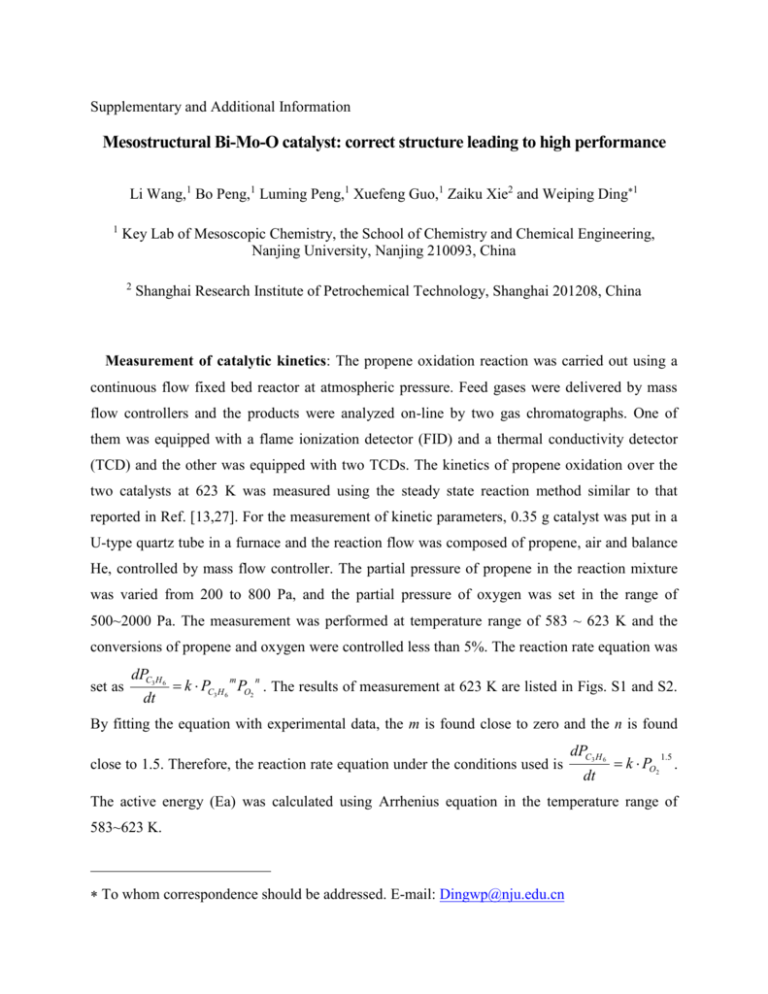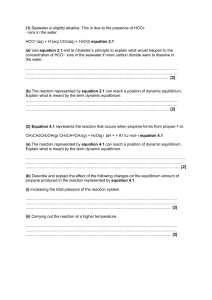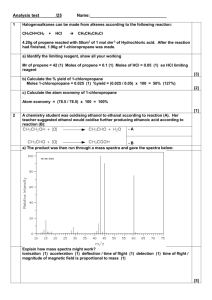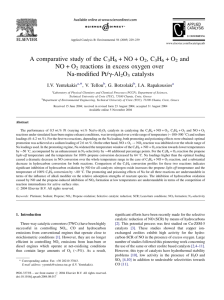srep02881-s1
advertisement

Supplementary and Additional Information Mesostructural Bi-Mo-O catalyst: correct structure leading to high performance Li Wang,1 Bo Peng,1 Luming Peng,1 Xuefeng Guo,1 Zaiku Xie2 and Weiping Ding1 1 Key Lab of Mesoscopic Chemistry, the School of Chemistry and Chemical Engineering, Nanjing University, Nanjing 210093, China 2 Shanghai Research Institute of Petrochemical Technology, Shanghai 201208, China Measurement of catalytic kinetics: The propene oxidation reaction was carried out using a continuous flow fixed bed reactor at atmospheric pressure. Feed gases were delivered by mass flow controllers and the products were analyzed on-line by two gas chromatographs. One of them was equipped with a flame ionization detector (FID) and a thermal conductivity detector (TCD) and the other was equipped with two TCDs. The kinetics of propene oxidation over the two catalysts at 623 K was measured using the steady state reaction method similar to that reported in Ref. [13,27]. For the measurement of kinetic parameters, 0.35 g catalyst was put in a U-type quartz tube in a furnace and the reaction flow was composed of propene, air and balance He, controlled by mass flow controller. The partial pressure of propene in the reaction mixture was varied from 200 to 800 Pa, and the partial pressure of oxygen was set in the range of 500~2000 Pa. The measurement was performed at temperature range of 583 ~ 623 K and the conversions of propene and oxygen were controlled less than 5%. The reaction rate equation was set as dPC3 H 6 dt k PC3 H 6 PO2 . The results of measurement at 623 K are listed in Figs. S1 and S2. m n By fitting the equation with experimental data, the m is found close to zero and the n is found close to 1.5. Therefore, the reaction rate equation under the conditions used is dPC3 H 6 dt k PO2 . 1.5 The active energy (Ea) was calculated using Arrhenius equation in the temperature range of 583~623 K. To whom correspondence should be addressed. E-mail: Dingwp@nju.edu.cn 0.0 -0.5 -1.5 -2.0 -2.5 623 K MoBi-m -1.5 Log rC3H6 -1.0 Log rC3H6 -1.2 623 K MoBi-c -3.0 -1.8 -2.1 -2.4 -3.5 -2.7 -4.0 2.3 2.4 2.5 2.6 2.7 2.8 2.9 3.0 3.1 -3.0 -1.20-1.12-1.04-0.96-0.88-0.80 Log PC3H6 Log PC3H6 Fig. S1 The variation of propene conversion rate with the partial pressure of propene in the reaction mixture. The partial pressure of oxygen was fixed at constant. The dots are experimental data and the dash line is the fitting curve. The m in the rate equation is close to zero. -1.50 -0.8 623 K MoBi-c -1.75 Log rC3H6 Log rC3H6 -1.0 -1.2 -1.4 623 K MoBi-m -2.00 -2.25 -1.6 -1.8 2.8 2.9 3.0 3.1 3.2 3.3 3.4 Log PO2 -2.50 2.48 2.56 2.64 2.72 2.80 2.88 Log PO2 Fig. S2 The variation of propene conversion rate with the partial pressure of oxygen in the reaction mixture. The partial pressure of propene was fixed at constant. The dots are experimental data and the dash line is the fitting curve. The n in the rate equation is close to 1.5. 0 MoBi-c MoBi-n -1 Ln k -2 Ea = 157 kJ/mol -3 -4 Ea = 199 kJ/mol -5 -6 1.59 1.62 1.65 1.68 1.71 -1 1000/T (K ) Fig. S3 The Arrhenius plot of the two catalysts in the temperature range of 583~683 K with the propene conversion controlled less than 5%. Table S1. Comparison of MoBi-m with industrial multicompoent bismuth molybdate catalyst (Shanghai Research Institute of Petrochemical Technology, Sinopec) under higher temperature and lower space velocity. [a] Conversion Selectivity[b] Yield [b] Ratio of acrolein Samples (%) (%) (%) to acrylic acid Industrial catalyst[c] 98.8 91.4 90.3 4.18 MoBi-m 98.3 94.9 93.3 4.36 -1 -1 [a] space velocity: 1000 ml g h ; propene: 4 ml/min; air: 29.2 ml/min; H2O: 5 mg/min; pressure: 998 mba; temperature: 648 K. [b] Selectivity and yield to acrolein and acrylic acid. [c] The industrial catalyst is from Shanghai Research Institute of Petrochemical Technology, Sinopec, composed of multi components as Bi-Mo-Fe-Co-Ni-Si-K-O, and the comparison measurement is carried out by the Shanghai Research Institute of Petrochemical Technology. 673 K Oxygen desorbed (a.u.) 323~673 K 10 K/min (c) MoBi-c MoBi-m 323 423 523 623 Temperature (K) 900 2100 3300 Soak time (s) Fig. S4 Results of O2 temperature-programmed desorption. Experiment condition: O2-TPD was conducted using Temperature-programmed desorption, measured with the Zeton-Altamira AMI-200 instrument. The sample weight was 0.3 g. The catalysts (MoBi-c and MoBi-m) were pretreated at 473 K for 1 h with a stream of helium. After cooling the catalyst sample to 323 K, oxygen was pre-adsorbed onto the catalyst sample for 10 h. Then, furnace temperature was increased from 323 K to 673 K at a rate of 10 K/min under a flow of helium and keep at 673 K for 1 h. The desorbed oxygen was detected using a TCD.







